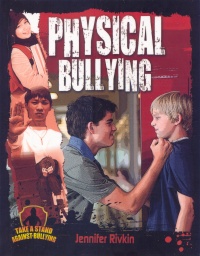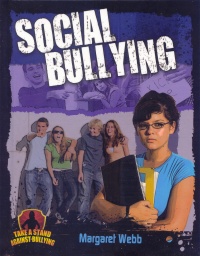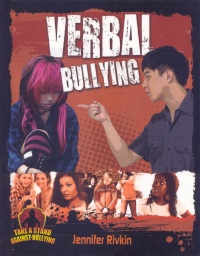| ________________
CM . . .
. Volume XIX Number 37. . . .May 24, 2013
excerpt:
Name-calling, mockery, teasing and taunting – to many adults, this sounds like typical verbal sparring amongst and between kids of any age. Some might view this as just a normal part of growing up. But, the recent tragedies of desperate teens (Amanda Ross, 2012, and Rehteah Parsons, 2013) who decided that suicide was the only escape from peer harassment in its many forms make it impossible to see bullying as a “normal” experience. Common, yes; normal, no. The four volumes of Crabtree’s latest series, “Take a Stand Against Bullying”, offer a timely perspective on bullying in its many forms as well as the situations and contexts in which it occurs. The publicity release for this series suggests that both the Reading and the Interest Levels for these books are aimed at students in Grades 5 through 8, but I think that the content will also work well for students in grades 9 through 12. As with a previous Crabtree series, “Dealing with Drugs”, these books feature large-font text, as well as edgy photos and graphics that have significant visual appeal for adolescent readers of nonfiction. Three of the four books are authored by different writers, but all share a common format. Each book is 48 pages long (available in either library binding or paperback), and almost every page features a picture, a pull quote, or a response to an eye-catching “Did you know?” query. The books all open with a vignette, usually situated in a school context, depicting the emotions and experience of a bullied student (the target), as well as the behaviours of a bully (or group of bullies). Sometimes, there are bystanders (individuals who witness the incident), but never are there allies (individuals who can assist the target). Each vignette concludes with a description of the emotional, psychological, and sometimes, physical pain experienced by the bullied student. The scenarios may be fictional, but they are powerful evocations of the reality of being bullied. Following each vignette is an “Introduction” page which defines “the nature of bullying”:
In all of the books, the first chapter following the “Introduction” focuses on defining a particular type of bullying (i.e. “What is Verbal/Physical/Social/Cyber-Bullying?) and then follows up with chapters detailing the specifics of that form of bullying (e.g. Social Bullying explores “why gossiping hurts”, and “why insults hurt”), the impact of bullying on the target/victim, understanding who is a bully and what motivates his or her behaviour, and the role that bystanders can, but don’t play in halting the abuse. All four books have common final chapters: “Empowerment” (“Beating the Bullies” in Cyber Bullying), “Other Resources” (two pages listing books, reliable web resources, and a listing of both Canadian and American organizations, hotlines, and helplines), and a “Glossary & Index” page which ends the book. Throughout the text of each book, unfamiliar words or terms are bold-faced and defined in the Glossary, and the Index, while brief, focuses on referencing those words or terms. Kids who have been bullied may have been told “that it’s best to ignore bullies, that everyone goes through it, and that there will always be bullying because there always has been” (Physical Bullying, p. 42). But no problem is ever solved by denial of its existence. The chapters on “Empowerment” all stress just how important it is for victims to enlist help from trusted adults as well as peers, provide tips for non-confrontational ways of handling bullies, and stress the importance of taking positive action to stop the profoundly destructive impact of bullying. Each of the chapters entitled “Are You a Verbal/Physical/Social/Cyber-Bully?” begins with a short quiz designed to have the student reader examine his or her past behaviours and recognize whether or not he or she has unwittingly been guilty of bullying. If the reader has, suggestions for change are offered. Well-intentioned though this chapter is, a 32 year career as a high school teacher makes me doubt that hard-core bullies will see themselves for who and what they are. However, for the student who really hasn’t assessed the fall-out of seemingly harmless actions - such as sending an e-mail or online greeting card from someone else’s account (Cyber Bullying, p. 44) – perhaps these chapters will help them to see the potential for unintended pain to others. Everyone knows what constitutes physical bullying, and the cover of Physical Bullying depicts a classic confrontation: one angry young man grabbing a younger, hapless-looking student, prior to slamming him into a locker. But, physical bullying is not just about hitting, kicking and slapping; there’s also theft and extortion and forcible confinement (locking someone in a locker or bathroom), all with the intention of intimidating and controlling the target through a sustained campaign of fear and aggression. Most of the photos in this book depict young males, either as bullies or targets, but, increasingly, girls are behaving badly, and when they do, hair-pulling and scratching happen (along with swearing, insults, and shunning of the victim). The schoolyard and its environs are the typical scenes of physical bullying, but it also happens in team locker rooms and sadly, in the home. If a kid is beaten up, the injury is plain to see. Less obvious are the emotional scars and the stress-related illness resulting from continual worry about when the bully will strike next. Who is targeted? Just about anyone who doesn’t “fit in” for any reason the bully and his cohorts decide: size, disability, apparent personality weakness, membership in a minority group (racial, religious, ethnic), poverty, being “a brain” or a “geek”, not being “a brain”. And, while the stereotypical image of the bully is of an individual with low self-esteem, difficulty in managing anger, and who can “use their size and strength to intimidate” (Physical Bullying, p. 29), it’s not always the case. Anyone who’s worked in a high school knows that students who are popular, apparently well-adjusted, and are high achievers can be bullies, too. They’re just less blatant in their approach and are more likely to use those strong social skills to engage in verbal or social bullying. Excluding someone from a group, malicious gossiping, and rumour-mongering are classic forms of social bullying. When “popular” and “cool” groups of students engage in this behaviour, school becomes hell on earth for the unfortunate target. Social Bullying defines this as “relational aggression, a form of social bullying common among tweens (ages 9 to 13), especially tween girls. A bully may act alone, or more often, with friends. The target of aggression is usually a friend within their group.” (Social Bullying, p. 10) As the old saying goes, “With friends like that, who needs enemies?” Abandoned by “frenemies” or betrayed in some way, it’s hard for the victim to feel anything but sadness:
It’s easy for an adult to say to Jasmyne, “This, too, will pass.” For a kid who feels like a social outcast, every day at school seems like an eternity, especially because bullies are good at making their victim feel as if she is completely deserving of her fate. Witness the comment of Chloe, age 14:
Chloe clearly enjoys her power, and although she’s feared, she’s probably also hated. Unless parents or teachers can make her aware of the damage that she’s inflicting, and more significantly, make her realize that there are consequences for her bad behaviour, it will continue into adulthood. Grown up, she’ll graduate to being a workplace bully, feared by many, despised by all. Social Bullying pays special attention to the importance of prevention and intervention in acts of social bullying. It champions a zero-tolerance approach to bullying behaviour, support for the target, and a “whole-school approach” in which teachers and students work together in creating an effective anti-bullying program, empowering students to become helpful bystanders, diminishing the “snitch” factor for students reporting incidents of bullying, and enforcing meaningful consequences for students who have bullied. It’s relatively easy to see for a teacher or parent to observe the results of physical and social bullying; verbal bullies are more careful about throwing insults at another kid, in the presence of another adult. The vignette which opens Verbal Bullying (Justine enters her school cafeteria and chooses a seat as far as possible from her nemesis, Stephanie, who proceeds to mock Justine’s weight and everything else she doesn’t like about her) is a typical junior high (and sometimes, senior high) incident. But, the chances of Stephanie’s insults actually being overheard by the teacher on lunchroom duty are remote. It can be hard to catch the verbal bully in the act. As noted by Julia, age 12: “I stutter. It gets worse when I’m nervous. The teacher won’t let the kids laugh at me in class, but when we’re outside they imitate and say things like l-l-l-l-l-loser. I feel like never opening my mouth again.” (Verbal Bullying, p. 14). The names and insults inflicted on targets are as varied as the reasons for which physical bullies beat up their victims or social bullies shun theirs. Quite simply, “for bullies, any point of difference is fair game”; the fact that “it probably won’t take you more than a few seconds to think of five mean words to describe someone who is overweight – that’s a sign of how prevalent verbal bullying is.” (Verbal Bullying, p. 14) Racial slurs, mocking an individual’s religion or ethnicity, arise from prejudice and stereotyping. Recently, homophobic comments have become the current insults of choice and have fallen into casual (ab)use even by students who would never consider that calling something or someone “gay” is verbal bullying. Furthermore, telling a teacher or school principal that one has been the target of verbal bullying can bring further retribution: being labeled as a “tattle, “snitch” or “rat” for having outed the bully. Still, “bullying is taken more seriously than ever before. . . . it can result in suspension, expulsion.” (Verbal Bullying, p.33). Other life consequences include failing to learn necessary social skills, developing empathy, and keeping friends. The role of bystanders (those who witness bullying) is explored in particular depth in Verbal Bullying; a bystander can be “hurtful” (either by joining in with the main perpetrator or by remaining silent, and through that silence, tacitly approving the action) or “helpful”, allying themselves with the victim, either by intervening to stop the bully or by reporting the incident to an adult. But, when it comes to cyber bullying, adults may feel completely out of their league. Technology has made it possible to send instant messages from anonymous IM (instant message) e-mail accounts, “tweet” false stories, slander someone on Facebook, cut and paste photos (often appending head shots to someone else’s naked body), post images of party antics that no one should ever have photographed, and on and on. In the past year, two Canadian teenagers have killed themselves because they couldn’t deal with online stalking, targeting and abuse. Cyber Bullying examines this phenomenon: a form of technology-delivered social bullying which “can be social death” (Cyber Bullying, p. 7) and, in the case of Amanda Ross and Reteah Parsons, suicide.
The speed with which a rumour can “go viral” makes old-school gossip look tame, and the anonymity afforded by digital communication add another menacing dimension to this form of social and verbal harassment. Cyber bullies are not always tough guys or mean girls; they may be unassuming “computer geeks” who is empowered by a keyboard and a computer screen. The “players” in cyber bullying also differ somewhat from those of classic bullying scenarios; anyone can be a target for any reason, and bystanders are often more passive : “simply watch[ing] what is happening and stay[ing] quiet to protect themselves. When bystanders forward embarrassing messages or photos, they are actually becoming bullies themselves.” (Cyber Bullying, p. 11) Intimate messages and photos often start off as loving, personal exchanges, but, if the relationship ends and things go badly, those notes and pictures can become highly embarrassing and very public. It’s also highly invasive to open up one’s computer or e-mail and find it filled with hateful messages. Add to all of this the power of blogs, Facebook and Twitter to disseminate information or disinformation, and the cyber-bully has an arsenal of digital ammunition. Scary, isn’t it? Targets of cyber bullying can feel particularly helpless. “Over half of teenagers who are targets of cyber bullying never actually report it. Targets often don’t know who is aware of the bullying, and when it’s anonymous, targets don’t know who they can trust. How do you report an attack that has no physical signs and is committed by a nameless and faceless attacker?” (Cyber Bullying, p. 28) Conversely, if a bully doesn’t see his or her victim, how likely is it that he or she can have any feelings of guilt or remorse? Nevertheless, it’s not impossible to combat cyber bullying. The best offence is defense, and “Are You at Risk?” (Cyber Bullying, p. 41) offers students a check list of behaviours (and some of them appear quite innocent to digital natives) to evaluate how likely it is that they have been or can be a victim of cyber bullying. Students can make choices not to pass along cyber gossip, not to share highly personal information, or text malice to others. And, if a student is the victim of cyber bullying, the chapter on “Reporting Cyber Bullying” offers productive strategies to deal with the situation and fight back. The “Take a Stand Against Bullying” series does an excellent job of providing a concise but comprehensive overview of the many forms which bullying can take. The series is undoubtedly aimed at students, but my past professional experience suggests that it would take a lot of courage for a target of bullying to come to the library, search for and select these books (of course, a sympathetic teacher-librarian would be more than willing to help, but t-l’s are in short supply in today’s school libraries). It’s not easy to admit that you are a victim of bullying; after all, destruction of personal confidence is one of a bully’s intentions. However, classroom teachers (and sooner or later, every teacher has to deal with bullying of one type or another, including the possibility that he or she might also be the target of cyber bullies), guidance and counseling staff will also find the books to be especially helpful resources for their student clients, and parents whose children are either targets or bullies will learn a great deal. And anyone who was picked on, for any reason at all during their time in school, will wrestle with memories and empathize with kids who are bullied. Highly Recommended. Joanne Peters, a retired teacher-librarian, lives in Winnipeg, MB.
To comment
on this title or this review, send mail to cm@umanitoba.ca.
Copyright © the Manitoba Library Association. Reproduction for personal
use is permitted only if this copyright notice is maintained. Any
other reproduction is prohibited without permission.
NEXT REVIEW |
TABLE OF CONTENTS FOR THIS ISSUE
- May 24, 2013.
AUTHORS |
TITLES |
MEDIA REVIEWS |
PROFILES |
BACK ISSUES |
SEARCH |
CMARCHIVE |
HOME |



